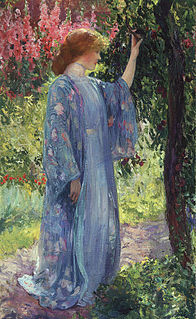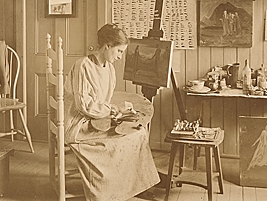
En plein air, or plein air painting, is the act of painting outdoors.
The California Art Club (CAC) is one of the oldest and most active arts organizations in California. Founded in December 1909, it celebrated its centennial in 2009 and into the spring of 2010. The California Art Club originally evolved out of The Painters Club of Los Angeles, a short-lived group that lasted from 1906–09. The new organization was more inclusive, as it accepted women, sculptors and out-of-state artists.

Theodore Nikolai Lukits was a Romanian American portrait and landscape painter. His initial fame came from his portraits of glamorous actresses of the silent film era, but since his death, his Asian-inspired works, figures drawn from Hispanic California and pastel landscapes have received greater attention.
Alexey Steele is an American painter of the Russian Representational School and a Soviet Art scholar. He moved to Los Angeles in 1990. Steele gained recognition for his unusual multi-figure compositions of an exceptionally large scale. His areas of expertise also include portraits, nudes and plein-air landscapes. Based on his interviews, Steele expresses strong interest in the direction of art in the 21st century.
Carolyn Mary Kleefeld is an English-American author, poet, and visual artist. She is the author of twenty-five books, has a line of fine art cards, and has had numerous gallery and museum awards and exhibitions between 1981 and the present, in New York City, Chicago, Los Angeles, San Francisco, and other major cities.
The contemporary realism movement is a worldwide style of painting which came into existence c. 1960s and early 1970s. Featuring a straightforward approach to representation practiced by artists such as Philip Pearlstein, Alex Katz, Jack Beal and Neil Welliver. The movement refers to figurative art works created in a natural yet highly objective style. Today the term Contemporary Realism encompasses all post-1970 sculptors and painters whose discipline is representational art, where the object is to portray the "real" and not the "ideal".
Arny Karl was one of the key artists in the early stages of the California Plein-Air Revival, which started in the 1980s and continues to this day. Along with Tim Solliday and Peter Seitz Adams, Karl helped revitalize the use of pastels to paint outdoors or en plein air, as the French described regarding the practice of working directly from nature. Karl was a student of Theodore Lukits (1897–1992), who was a prominent California Impressionist and the best known Early California painter to have worked in pastel. His work has been included in a number of museum exhibitions, is represented in a number of prominent public and private collections and has been the subject of a number of curatorial essays.
Peter Seitz Adams is an American artist. His body of work focuses on landscapes and seascapes created en plein air in oil or pastel as well as enigmatic figure and still-life paintings. He is noted for his colorful, high-key palette and broad brushwork. Adams has held numerous solo and group exhibitions in galleries and museums, including throughout California, the Western United States, and on the East Coast in Philadelphia, Vermont, and New York. Adams is the longest serving President of the California Art Club and has served on its board of directors in Pasadena, California from 1993 to 2018. He is also a writer on subjects relating to historic artists for the California Art Club Newsletter, as well as for a number of the organization's exhibition catalogs.

The terms California Impressionism and California Plein-Air Painting describe the large movement of 20th century California artists who worked out of doors, directly from nature in California, United States. Their work became popular in the San Francisco Bay Area and Southern California in the first three decades after the turn of the 20th century. Considered to be a regional variation on American Impressionism, the California Impressionists are a subset of the California Plein-Air School.
Tim Solliday is a contemporary California Plein-Air Painter and Western Artist who is known for his San Gabriel Valley landscapes and his paintings of American Indians and other western subjects. He studied with the California Impressionist portrait and landscape painter Theodore Lukits (1897–1992) in the 1970s and began working professionally in the early 1980s. Solliday is described as a painter with a "muscular, masculine style" and has been compared to artists of the Taos Ten, especially E. Martin Hennings. He is a Signature Member of the California Art Club. He exhibits with the Laguna Plein-Air Painters Association, the Oil Painters of America and at the Maynard Dixon Invitational, which is held in Utah each year. Solliday's work has been featured in a number of American art magazines such as Southwest Art, American Artist and Art of the West. Through his plein-air work in the pastel medium and large canvasses, he has played an important role in the revival of landscape painting in Southern California.
Tonal Impressionism was an artistic style of "mood" paintings with simplified compositions, done in a limited range of colors, as with Tonalist works, but using the brighter, more chromatic palette of Impressionism. An exhibition titled "Tonal Impressionism" was curated by the art historian Harry Muir Kurtzworth for the Los Angeles Art Association Gallery at the Los Angeles Central Library in June 1937 with the works of a number of prominent California artists. In recent years, the term has also been used to describe a non-linear approach to painting where the subject is massed in with tonal values without the use of underdrawing.

Richard E. Miller was an American Impressionist painter and a member of the Giverny Colony of American Impressionists. Miller was primarily a figurative painter, known for his paintings of women posing languidly in interiors or outdoor settings. Miller grew up in St. Louis, studied in Paris, and then settled in Giverny. Upon his return to America, he settled briefly in Pasadena, California and then in the art colony of Provincetown, Massachusetts, where he remained for the rest of his life. Miller was a member of the National Academy of Design in New York and an award-winning painter in his era, honored in both France and Italy, and a winner of France's Legion of Honor. Over the past several decades, he has been the subject of a retrospective exhibition and his work has been reproduced extensively in exhibition catalogs and featured in a number of books on American Impressionism.

Decorative Impressionism is an art historical term that is credited to the art writer Christian Brinton, who first used it in 1911. Brinton titled an article on the American expatriate painter Frederick Carl Frieseke, one of the members of the famous Giverny Colony of American Impressionists, "The Decorative Impressionist."

Agnes Lawrence Pelton (1881–1961) was a modernist painter who was born in Germany and moved to the United States as a child. She studied art in the United States and Europe. She made portraits of Pueblo Native Americans, desert landscapes and still lifes. Pelton's work evolved through at least three distinct themes: her early "Imaginative Paintings," art of the American Southwest people and landscape, and abstract art that reflected her spiritual beliefs.

Kevin A. Short is an American painter and printmaker, recognized for his modern landscapes of the Pacific Coast and American Southwest. He is considered an integral observer and portrayer of the surfing subculture. His use of heavy brushstrokes and vivid pigments are a recognizable trademark of his painting style.

William Newport Goodell (1908–1999) was an American artist, craftsman, and educator. He was born August 16, 1908 in Germantown, Philadelphia and briefly attended the Pennsylvania Academy of the Fine Arts (PAFA), including its country school in Chester Springs, studying under Pennsylvania impressionist Daniel Garber and noted academician Joseph Thurman Pearson, Jr., before opening his own studio on Germantown Avenue in 1929.
Karl Dempwolf is a contemporary California Plein-Air Painter who is known for his California Landscapes. He is a Signature Member of the California Art Club, and serves in its Advisory Board of Directors.

The Frederick R. Weisman Museum of Art is an art gallery on the campus of Pepperdine University in Malibu, California. The museum was founded in 1992 with a $1.5 million gift from Frederick R. Weisman, a noted art collector and philanthropist. The museum exhibits art from around the world, but focuses on art from California.
Jean Stern, Director Emeritus of The Irvine Museum is an art historian and retired museum director who specializes in paintings of the California Impressionist period (1890-1930).
Michael Zakian was an American art historian and museum curator. He was the director of the Frederick R. Weisman Museum in Malibu, California for 25 years until his death in 2020. His academic research focused on abstract expressionism.








